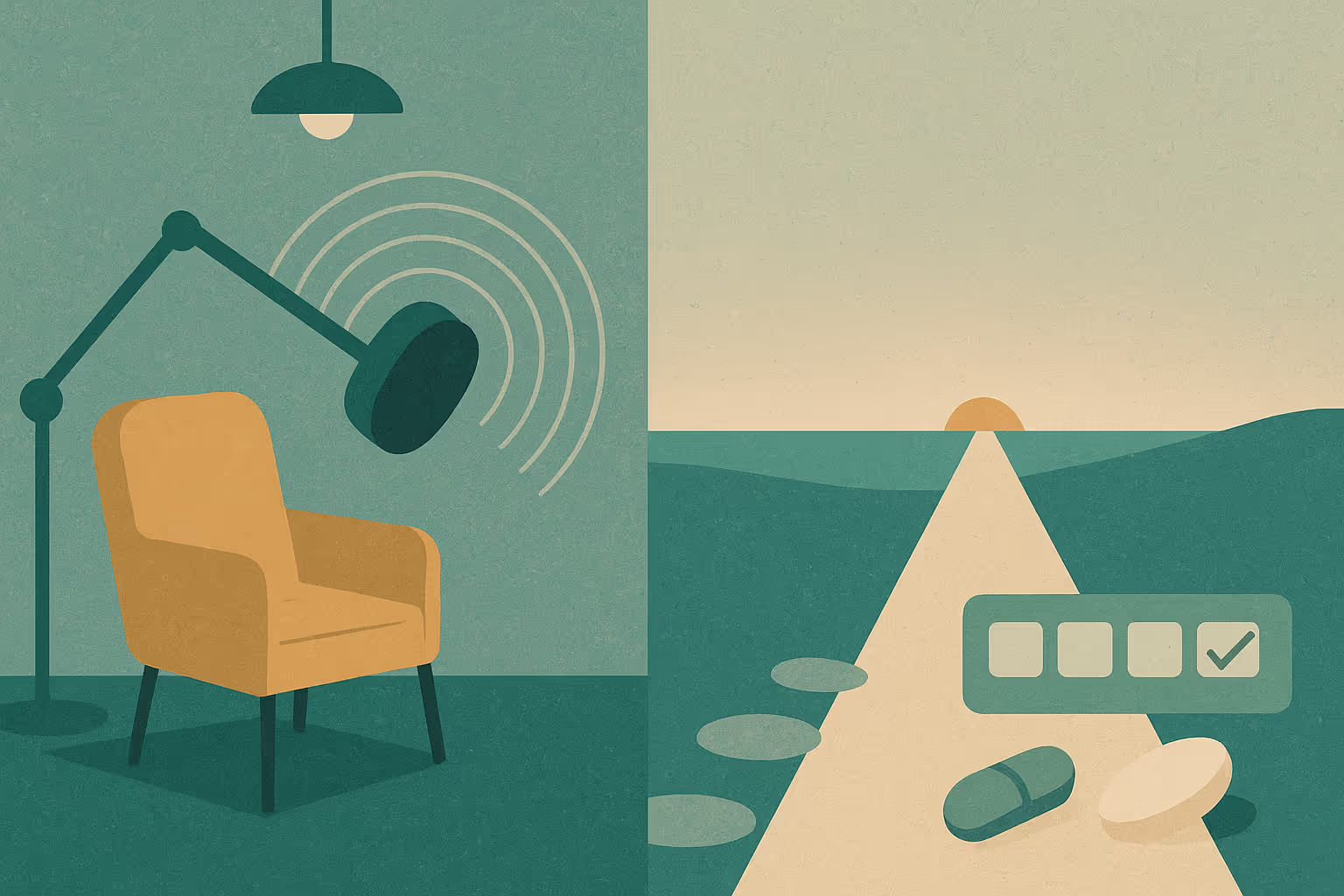Psychiatrists & Ketamine Therapy: A Constructive Partnership
“We see ourselves in a consultative role — supporting the outpatient psychiatrist’s work, not replacing it.”
— Benjamin Yudkoff, MD, Chief Medical Officer and Co-Founder, Lumin Health
Psychiatrists sit at the center of their patients’ mental health treatment journeys. Psychiatrists know the full medication history, the course of past antidepressants, and the stories behind each clinical plateau. When standard pharmacologic options lose traction, ketamine therapy and esketamine (Spravato) can offer another route — one that can work quickly, safely, and in partnership with you.
At Lumin Health, psychiatrists are not bystanders to these treatments; they are leaders in them. Our care model is designed around continuity — so while our team manages dosing, monitoring, and safety, you remain the clinical anchor for your patient’s long-term plan.
Ketamine Therapy at Lumin Health: From Consultation to Collaborative Care
Determining Eligibility and Medical Fit
Psychiatrists are often the first to recognize when a patient may benefit from ketamine therapy or Spravato treatment. The signs are familiar: multiple antidepressant trials with limited effect, chronic suicidal ideation, or rapid relapse after medication changes.
Lumin Health offers no-cost medical-necessity evaluations to confirm safety and appropriateness. Before referral, a psychiatrist might consider:
- Has the patient tried at least two antidepressants at therapeutic doses?
- Is depression or suicidality persistent despite adherence?
- Is blood pressure controlled?
- Are there any exclusion factors (e.g., active psychosis, pregnancy, recent cardiovascular events)?
As Dr. Yudkoff notes, “We’re happy to help hospitals and outpatient teams think through continuity of care. Our goal is constant and thorough communication.”
That principle at Lumin Health applies across all settings: we meet patients where they are, in collaboration with the providers who know them best.
The Referral Pathway to Ketamine Treatment
Referring a patient is straightforward. Psychiatrists can initiate contact through a secure referral form, a direct clinician-to-clinician call, or EHR-based documentation.
In the initial referral to ketamine therapy, we ask for:
- Diagnosis and current medication list
- Treatment-resistance history
- Risk factors or comorbidities
- Preferred contact for updates
- Other notes that may be constructive to building context
Patients sign a consent release so that information flows both ways. We handle dosing and medical oversight; you maintain longitudinal management of psychotropics, follow-up therapy, and functional progress.
“The outpatient provider remains at the helm; Lumin Health is solely here to support the patient’s journey to recovery.” — Dr. Yudkoff
Safety, Communication, and Follow-Up are Crucial to Ketamine Therapy
Shared Safety Oversight
All ketamine and esketamine (Spravato) sessions occur in certified, medically supervised environments. Each patient receives a baseline assessment, continuous monitoring during dosing, and observation until full re-orientation.
If safety concerns arise — emergent suicidality, blood-pressure changes, or non-response — we contact the referring psychiatrist immediately for joint decision-making.
“Trust is one of the values that helps make the treatment safer. If a member of the care team doesn’t sufficiently trust the treatment, it might not be the right treatment for that patient, because that uncertainty can enter the patient’s experience.” — Dr. Yudkoff
Our shared trust in both the science and the collaboration is what keeps patients safe.
Update Cadence and Documentation
Psychiatrists receive structured communication at three intervals:
- Initial Evaluation Summary – confirming eligibility, safety findings, and dosing route.
- Mid-Series Progress Report – summarizing response, side effects, and clinical trajectory.
- Completion Summary – providing outcomes and guidance for maintenance or relapse prevention.
If your patient remains in treatment longer-term through maintenance ketamine dosing or continued esketamine (Spravato) sessions, periodic updates from Lumin Health to the referring psychiatrist continue at agreed intervals. All communication is concise, secure, and written for clinical utility — no guesswork, no ambiguity.
“Communication may not be complicated, but it’s no less important.” — Dr. Yudkoff
When to Pause or Adjust Ketamine Dosing
Sometimes, the psychiatrist is the first to sense instability — insomnia, irritability, or functional regression. In those cases, collaboration becomes immediate and even more impactful.
- We recommend that you contact the Lumin Health team directly.
- We review dose frequency and response data.
- Adjustments are made jointly, never unilaterally.
Our aim is shared stewardship, not parallel silos. Every psychiatrist remains a full partner in clinical oversight.
Returning Patients to In-Practice Care after a Ketamine Therapy Induction Course
Once the acute treatment phase concludes, patients transition back to your full management. Lumin Health provides:
- A clear summary of sessions and clinical response
- Recommendations for maintenance frequency (if applicable)
- Any safety or medication considerations observed during dosing
Patients often describe feeling an accelerated return of hope and capacity. That renewed stability allows their ongoing psychiatric care — medications, psychotherapy, and lifestyle interventions — to work more effectively.
For many psychiatrists, the shift is tangible: patients re-engage faster, tolerate their medications better, and approach follow-up visits with a sense of traction that had been missing.
“We see ourselves as a consultative partner — one part of a continuum that the outpatient psychiatrist leads.” — Dr. Yudkoff
Psychiatrists & Ketamine Therapy: A Constructive Partnership
Psychiatrists remain the cornerstone of coordinated care at Lumin Health. This piece outlines how referral, safety, and follow-up work in tandem to preserve continuity while expanding treatment options through ketamine therapy and Spravato treatment.
The model is simple but powerful: psychiatrists identify readiness, Lumin manages dosing and monitoring, and communication keeps everyone aligned. This becomes a shared rhythm of care that helps patients recover faster, stay safer, and move forward with confidence.







